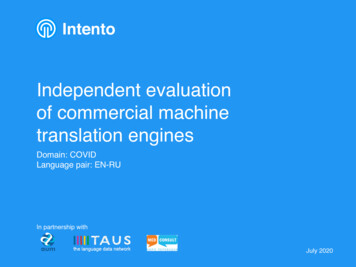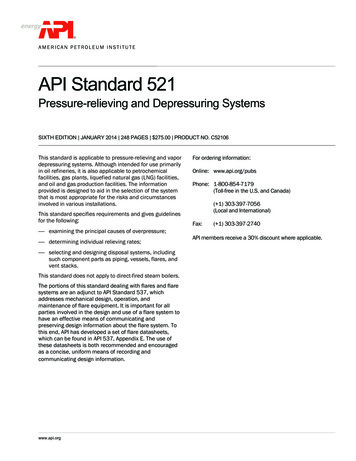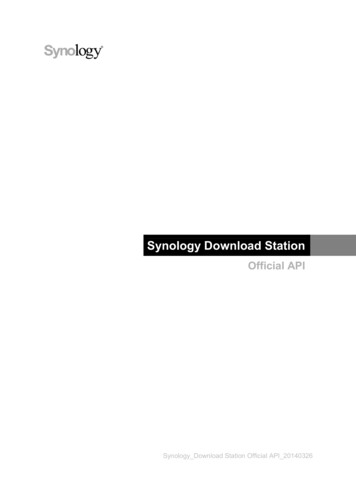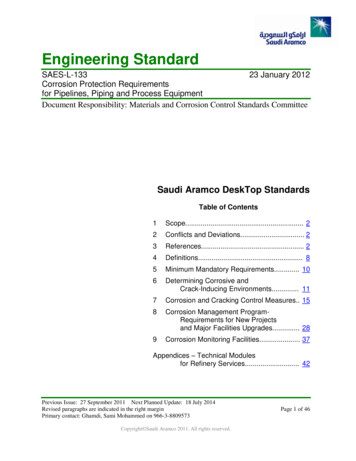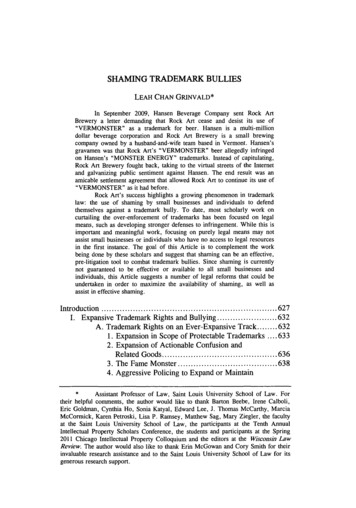
Transcription
SHAMING TRADEMARK BULLIESLEAH CHAN GRINVALD*In September 2009, Hansen Beverage Company sent Rock ArtBrewery a letter demanding that Rock Art cease and desist its use of"VERMONSTER" as a trademark for beer. Hansen is a multi-milliondollar beverage corporation and Rock Art Brewery is a small brewingcompany owned by a husband-and-wife team based in Vermont. Hansen'sgravamen was that Rock Art's "VERMONSTER" beer allegedly infringedon Hansen's "MONSTER ENERGY" trademarks. Instead of capitulating,Rock Art Brewery fought back, taking to the virtual streets of the Internetand galvanizing public sentiment against Hansen. The end result was anamicable settlement agreement that allowed Rock Art to continue its use of"VERMONSTER" as it had before.Rock Art's success highlights a growing phenomenon in trademarklaw: the use of shaming by small businesses and individuals to defendthemselves against a trademark bully. To date, most scholarly work oncurtailing the over-enforcement of trademarks has been focused on legalmeans, such as developing stronger defenses to infringement. While this isimportant and meaningful work, focusing on purely legal means may notassist small businesses or individuals who have no access to legal resourcesin the first instance. The goal of this Article is to complement the workbeing done by these scholars and suggest that shaming can be an effective,pre-litigation tool to combat trademark bullies. Since shaming is currentlynot guaranteed to be effective or available to all small businesses andindividuals, this Article suggests a number of legal reforms that could beundertaken in order to maximize the availability of shaming, as well asassist in effective shaming.627.Introduction. 632I. Expansive Trademark Rights and Bullying .A. Trademark Rights on an Ever-Expansive Track.6321. Expansion in Scope of Protectable Trademarks . 6332. Expansion of Actionable Confusion andRelated Goods.636. 6383. The Fame Monster .4. Aggressive Policing to Expand or Maintain*Assistant Professor of Law, Saint Louis University School of Law. Fortheir helpful comments, the author would like to thank Barton Beebe, Irene Calboli,Eric Goldman, Cynthia Ho, Sonia Katyal, Edward Lee, J. Thomas McCarthy, MarciaMcCormick, Karen Petroski, Lisa P. Ramsey, Matthew Sag, Mary Ziegler, the facultyat the Saint Louis University School of Law, the participants at the Tenth AnnualIntellectual Property Scholars Conference, the students and participants at the Spring2011 Chicago Intellectual Property Colloquium and the editors at the Wisconsin LawReview. The author would also like to thank Erin McGowan and Cory Smith for theirinvaluable research assistance and to the Saint Louis University School of Law for itsgenerous research support.
626WISCONSIN LAW REVIEW. 640.Trademark RightsB. Trademark Bullying.641. . . . . . . . . . . . . 6421. What is Trademark Bullying?a. Unreasonable Interpretation of Trademark. 643.Rights. 645b. Intimidation Tactics. 646(i) Undue Economic Pressure. 648(ii) Coercive Persuasionc. Trademark Holder Is a Large Corporationand Accused Infringer Is a Small Business. 649.or Individual. 6502. Societal Harms Produced by Bullying.andSmallBusinessesII. Fighting Back: Problems FacingIndividuals.653A. Why Small Businesses and Individuals Cannot. 654Litigate Trademark Disputes.6541. Lack of Infrastructure . 6562. Lack of Monetary Resources .B. Why Small Businesses and Individuals Should Not. 657Litigate Trademark Disputes1. Lack of Precedential Value of Previously. 658Litigated Trademark Cases.2. Lack of Defenses to Trademark Infringement . 6603. Lack of Consequences for Abuse of. 661Trademark Rights. 664III. Shaming Trademark Bullies . 665A. Shaming and the Conditions for Success .B. Why Does Shaming Trademark Bullies Have the. . . . . . . . . . 668Potential to Be Effective? . . . . . .1. Community.6692. Shared N orm s.6703. Large Corporations Are Vulnerable to Shaming . 6724. Small Businesses and Individuals are Credible674.ShamersC. Advantages and Disadvantages of Shaming . 676. 6771. Advantages of Shaming2. Disadvantages/Objections to Shaming.679IV. Proposed Legal Reforms to Harness the Power of Shaming. .683. 683A. Providing Protected Spaces for Shaming ."GroundlessShaming:TheEffectiveB. Assisting inThreats of Trademark Infringement" Cause of684Action .C. Promoting Responsible Shaming.687Conclusion.688
Shaming TrademarkBullies2011:625627INTRODUCTIONIn September 2009, Hansen Beverage Company sent Rock ArtBrewery a letter demanding that Rock Art cease and desist its use of"VERMONSTER" as a trademark for beer.' The letter stated, in part,"To protect [Hansen's] rights, we must insist that you . . .[i]mmediately cease and desist from any distribution, sale or other useof VERMONSTER in connection with beverages, including the use ofany advertising, promotional and point-of-sale materials that include theinfringing mark . . . ."2 Hansen is a multi-million-dollar beveragecorporation and Rock Art Brewery is a small brewing company ownedby a husband-and-wife team based in Vermont.' Hansen's gravamenwas that Rock Art's "VERMONSTER" beer allegedly infringed onHansen's "MONSTER ENERGY" trademarks.4 Instead of capitulating,Rock Art Brewery fought back, taking to the virtual streets of theInternet and galvanizing public sentiment against Hansen.5 Rock ArtBrewery's YouTube video garnered over fifty thousand viewers in thefirst couple of days of its posting,' and over ten thousand members inthe Facebook group, "Vermonters and Craft Beer Drinkers AgainstMonster."' The end result was an amicable settlement agreement thatallowed Rock Art to continue its use of "VERMONSTER" as ithad before.1.See Letter from Diane Reed, Attorney, Knobbe Martens Olson & BearLLP, to Christopher J. Day, Law Office of Christopher Day (Sept. 4, 2009).2.Id.See Jack Katzanek, Hansen Settles Trademark Dispute with Brewer, THE3.PREss-ENTERPRISE, (Oct. 23, 2009, 9:52 AM), http://www.pe.com/business/local/stories/PEBiz S monster23.39559bf.html.See Letter from Diane Reed, supra note 1.4.See Matt vs. Monster, GREEN RIVER PICTURES, http://www.grpvt.com/5.mattvsmonster (last visited Apr. 2, 2011); Save Vermonster, Save Rock Art Brewery,LOST IN THE BEER AISLE (Oct. 14, 2009), http://www.lostinthebeeraisle.com/2009/10/save vermonster-save-rock-artbrewery.html; Vermonters and Craft BeerDrinkers Against Monster, FACEBOOK, http://www.facebook.com/group.phpgid 171894902802&ref nf (last visited Mar. 12, 2011).6.Matt and "The Monster"-Rock Art Brewery vs. Monster Energy Drink,YouTUBE, http://www.youtube.com/watch?v kbG woqXTeg (last visited Apr. 18,2011) (follow document statistics).See Adam Ostrow, Social Media Users Rally Behind Vermont Brewery vs7.Monster Energy Drink, MASHABLE (Oct. 16, 2009), http://mashable.com/2009/10/16/vermonster/.See Press Release, Hansen Beverage Company and Rock Art Brewery8.Reach Trademark Agreement (Oct. 22, 2009) (on file with author).
628WISCONSIN LAW REVIEWThe attack on Rock Art Brewery by a large corporation is not aunique one. Unfortunately for small-business owners and individuals,large corporations have embarked on "cease and desist" campaigns thatare intended to "bully" these small businesses and individuals intocompliance. 9 Large corporations send out multitudes of lettersdemanding small businesses or individuals cease and desist in their useof a trademark that has some resemblance to a large corporation'strademark(s).o On many occasions, these letters appear to be sent outwithout any analysis of the purported infringement." These letters seemintended to simply intimidate the small business or individual intoforgoing the use and/or registration of their trademark.' 2 Theintimidation factor is high, as often the letter is sent by a law firm orthe large corporation's legal department to the small-business owner orindividual (who is typically not a lawyer).' 3 The letter is generallywritten in legalese, citing court cases that may or may not be relevantto the small-business owner or individual.14 The large corporation'srights are often vaguely stated, and the "fame" of the corporation'strademark(s) often overstated." In addition, the letter often claims that9.See generally DAVID BOLLIER, BRAND NAME BULLIES: THE QUEST TOOWN AND CONTROL CULTURE (2005) (documenting various bullying campaigns).10.See id.at 5.See Stacey Knapp, Balancing the Crucible: The Revolving Conflict11.Between Fair Use and Corporate Use in the Battle to ControlDomain Names, 1 OKLA.J. L. & TECH. 10, 17-18 (2004), http://www.okjolt.org/index.php?option comcontent&view article&id 84:1-jl-a-tech-10-2004-&catid 42:special-features&Itemid 65 (discussing Warner Brothers' tactics in bullying owners of domain namesthat incorporate any item related to the Harry Potterbook-series franchise).See K.J. Greene, Abusive Trademark Litigation and the Incredible12.Shrinking Confusion Doctrine- Trademark Abuse in the Context of EntertainmentMedia and Cyberspace, 27 HARV. J.L. & PUB. POL'Y 609, 632 (2004) ("The'effectiveness of lawsuits to silence corporate critics derives in part from the disparityof resources between the plaintiff corporation and the defendant . . . .'" (quoting SarahMayhew Schlosser, The High Price of (Criticizing)Coffee: The Chilling Effect of theFederal Trademark Dilution Act on Corporate Parody, 43 ARIz. L. REv. 931,948 (2001)).13.For example, among small-business owners, only 8.3 percent haveattained a professional degree. See Chad Moutray, BaccalaureateEducation and theEmployment Decision: Self-Employment and the Class of 1993, at 30 (Oct. 2008)(Office of Advocacy, U.S. Small Bus. Amin., unnumbered working paper), 333tot.pdf. While a small percentage of smallbusiness owners have a graduate degree, it is likely that not all of these graduatedegrees are law degrees.See, e.g., Letter from National Football League, to Ms. Thom, Fleurty14.Girl (Jan. 13, 2010).See, e.g., Letter from Diane Reed, supra note 1 ("Hansen created,15.manufactures and distributes the MONSTER ENERGY line of drinks and supplementsunder its famous MONSTER and MONSTER ENERGY mark." (emphasis added)).Being "famous" in trademark law is a term of art, requiring a high burden of proof.
2011:625Shaming TrademarkBullies629the small-business owner or individual will have to pay attorney'sfees." Finally, an extremely short time-frame for a response by thebullying victim is demanded.17This bullying is a serious concern, as it has implications farbeyond trademark law and impacts the U.S. economy and the freedomof cultural expression.'" One of the harms produced by bullying is thateconomic competition is impaired.' 9 In particular, small businesses andindividuals are more adversely affected, as these victims do not havethe wherewithal to fight legal battles. While changing or ceasing to usethe trademark at stake without a battle may seem to be the leastexpensive option, altering a trademark (especially if it is also thebusiness's name) can be an expensive proposition.20 In addition, it isnot merely a change in trademark that the bully demands, but also acessation of sales of goods bearing the trademark, along with anymarketing materials, and, further, the delivery of the remainingproducts bearing the trademark to the bully (presumably fordestruction), along with an accounting of past profits." For a smallbusiness, the destruction of inventory and the payment of a licensingfee may push the business into bankruptcy, which reduces the potentialSee 15 U.S.C. § 1125(c)(2)(A) (2006) ("[A] mark is famous if it is widely recognizedby the general consuming public of the United States as a designation of source of thegoods or services of the mark's owner.").See, e.g., Letter from Diane Reed, supra note 1.16.17.See id. (providing two weeks from date of letter); Letter from NationalFootball League, supra note 14 (providing nine days from date of letter).18.See ROSEMARY J. COOMBE, THE CULTURAL LIFE OF INTELLECTUALPROPERTIES: AUTHORSHIP, APPROPRIATION, AND THE LAW 66 (1998) ("[Trademark law]becomes the ruse by which corporations protect themselves from competition and fromuncompensated circulation of their cultural indicators.").19.For in-depth discussions of other harms arising from trademark bullying,including violations of the First Amendment and harms to consumers, see generallyBOLLIER, supra note 9, at 188-89, Eric Goldman, Online Word of Mouth and ItsImplications for Trademark Law, in TRADEMARK LAW AND THEORY: A HANDBOOK OFCONTEMPORARY RESEARCH 404 (Graeme B. Dinwoodie & Mark D. Janis eds., 2008)[hereinafter TRADEMARK LAW AND THEORY], Greene, supra note 12, and William E.Ridgway, Revitalizing the Doctrine of Trademark Misuse, 21 BERKELEY TECH. L.J.1547 (2006).20.See Russell L. Parr,The Value of Trademarks, in TRADEMARKS,COPYRIGHTS, AND UNFAIR COMPETITION FOR THE GENERAL PRACTITIONER 229, 246(Am. Law Inst.-Am. Bar Assoc. Comm. on Continuing Prof 1 Educ., Course of StudyMaterials No. C913, 1994) ("[Llarge-scale introduction of a new trademark carriesenormous costs."); Peter Robison, Time Wamer, Broadwing, Change Names AfterLosses, IGOR (Oct. 16, 2003), orporate-business-name.php ("Changing a corporate name can take a year and costtens of millions of dollars.").See, e.g., Letter from National Football League, supranote 14.21.
630WISCONSIN LAW REVIEWfor competition for the bully.2 2 Even for individuals with nocommercial interest at stake, complying with a cease-and-desist lettercan still be expensive, as some letters demand payment of attorney'sfees even if the recipient agrees to cease in its use of the trademark.23Trademark law and the legal system, as both currently operate,work to assist, and perhaps even encourage, the bully's efforts.Trademark litigation is expensive, time consuming, and emotionallydraining. Even if victims of bullying are able to access low-cost or freelegal assistance, the non-monetary costs may continue to outweigh thebenefits of fighting (even where the victim has a strong case).24 Inaddition, trademark law and the standards for infringement arenotoriously malleable, and prior case law provides very little by way ofguidelines for attorneys to advise victims on the probability of winningtheir lawsuits.25 While many scholars and commentators have beenfocused on curing the deficiencies of trademark law, such as proposingthe need for stronger defenses to trademark infringement,2 6 focusing onsuch cures (which mainly assist only once a lawsuit has beencommenced) will not assist in those numerous cases that never see the22.Starting a business is a resource-intensive undertaking and many smallbusinesses operate at a very small margin of error, as proprietors often underestimatethe amount of capital needed to run the business in the first few years. See generallyMARY JANE BYRD & LEON C. MEGGINSON, SMALL BUSINESS MANAGEMENT: ANENTREPRENEUR'S GUIDE 13, 25, 181 (6th ed. 2009). Approximately 50 percent of allsmall businesses fail within the first five years of operation. See Get Ready, U.S.SMALL BUSINESS ADMINISTRATION, ady/SERV SBPLANNERISENTFORU.html (last visited Nov. 4, 2010) (on filewith author; webpage is no longer available). As such, any unexpected expense or cost,such as a loss of inventory and payment of attorney's fees may push the businessinto bankruptcy.23.See, e.g., Letter from Diane Reed, supra note 1.Non-monetary costs may include the emotional strain of being involved in24.litigation. For example, when Ford Motor Corporation sued seven individuals to gaincontrol over domain names that included one of Ford's purported trademarks("FORD," "JAGUAR," etc), the Electronic Frontier Foundation provided free legalassistance. See EFF Wins a Partial Victory in Ford Case, EFFECTOR, Jan. 10, tml#ll. Notwithstanding the free legalassistance, two of the defendants decided not to pursue the litigation, citing theemotional strain of the litigation. See BOLLIER, supra note 9, at 126.25.See infraPart II.B.1.See generally Graeme Dinwoodie, Developing Defenses in Trademark26.Law, 13 LEWIS & CLARK L. REv. 99 (2009) (arguing for courts to adopt strongeraffirmative trademark defenses); Michael Grynberg, Things Are Worse Than WeThink: TrademarkDefenses in a "Formalist"Age,24 BERKELEY TECH. L.J. 897 (2009)(arguing for statutory amendments to encapsulate stronger trademark defenses);William McGeveran, Rethinang Trademark Fair Use, 94 IOWA L. REv. 49 (2008)(arguing for a stronger fair-use defense).
2011:625Shaming TrademarkBullies631inside of a courtroom.7 Small businesses and individuals need tools todefend themselves against trademark bullies without the needfor litigation.This Article suggests one tool that has been gaining popularity withsmall businesses and individuals (such as in Rock Art Brewery's case):shaming trademark bullies.2 ' The goal of this Article is to complementthe work being done by scholars on methods of curing trademark lawdeficiencies. This Article argues that shaming can be used by smallbusinesses and individuals as a litigation alternative to stop the bullyingwithout having to resort to the courts. However, shaming is notguaranteed to be successful or even low-cost. Nonetheless, shamingmay be an effective alternative to litigation because the upfrontmonetary costs are low (relative to litigation), and it is one avenue forsmall businesses and individuals to obtain low-cost or free legaladvice.29 In order to maximize the shaming benefits, this Articleidentifies three legal reforms that would make shaming more effective:providing protected spaces for shaming, adopting a "groundlessthreats" cause of action,30 and promoting responsible shaming.Together, these reforms would increase the likelihood of shamingsuccess and work to reduce trademark bullying.This Article proceeds in five parts. Part I looks at variousexpansions in trademark law that have contributed to, and perhapsfueled, trademark bullying. In addition, Part I provides a systematicanalysis of the current practices of trademark bullies, before turning inPart II to the unique issues facing small businesses and individuals inattempting to mount a defense against a trademark bully. Thisexamination includes a discussion of how legal avenues are insufficientWhile strong defenses may help in the pre-litigation stage (because strong27.defenses can convince a bully that their trademark-infringement case is not a strongone), where the bullying victim is a small business or individual, trademark bullies maychoose to ignore defense arguments because it is common knowledge that such victimswill likely not have the resources to make the same arguments in litigation.28.Although shaming has been widely written about in the criminal context,see Dan M. Kahan, What Do Alternative Sanctions Mean?, 63 U. CHI. L. REv. 591,631-53 (1996); Dan M. Kahan & Eric A. Posner, Shaming White-Collar Criminals:AProposal for Reform of the Federal Sentencing Guidelines, 42 J.L. & ECON. 365(1999), it has received only sporadic, descriptive coverage in the intellectual propertycontext. See Mark F. Schultz, Fearand Norms and Rock & Roll: What Jambands CanTeach Us About PersuadingPeople to Obey Copyright Law, 21 BERKELEY TECH. L.J.651, 681-88 (2006) (describing shaming as a sanction in the jamband community);Dotan Oliar & Christopher Sprigman, There's No Free Laugh (Anymore): TheEmergence of Intellectual Property Norms and the Transformation of Stand-UpComedy, 94 VA. L. REV. 1787, 1824-25, 1862 (2008) (describing shaming as asanction for comedians who infringe on other comedians' material).29.See infra Part III.C.1.30.Cf Trade Marks Act, 1994, c. 26, §21 (Eng. & Wales).
WISCONSIN LAW REVIEW632to assist small businesses and individuals. Part III turns to shaming andthe argument that shaming will be effective in the trademarkenforcement context. In addition, Part III provides an overview of someof the advantages and disadvantages to shaming. Part IV addressesthese disadvantages by proposing legal solutions to make shaming moreeffective. This Article concludes in Part V.I. EXPANSIVE TRADEMARK RIGHTS AND BULLYINGIt is a truism that trademark rights have been on an expansive tracksince the early twentieth century.31 While the use of the law by bulliesto coerce small businesses and individuals into cooperation is notunique to trademark law, there is. a sentiment that such bullying hasreached levels of concern in the trademark arena.32 Although merelyexpanding the law to provide stronger protection to trademark ownersdoes not, in and of itself, cause bullying, simultaneous developmentshave assisted in incentivizing bullying, including increased protectiongiven to strong or famous trademarks and a lack of meaningfuldevelopments to assist those accused of trademark infringement.33 ThisPart provides a brief and simplified overview of these developmentsthat have expanded the rights of trademark owners and have pushedsuch owners to abusive tactics in order to capture and maintain theirexpanded rights.34 In addition, this Part provides an analysis oftrademark bullying.A. TrademarkRights on an Ever-Expansive TrackThe basic concept of a trademark as a symbol that identifies thesource of a product" is perhaps the only item that has remained31.See Lionel Bently, From Communication to Thing: HistoricalAspects ofthe Conceptualisationof Trade Marks as Property, in TRADEMARK LAW AND THEORY,supra note 19, at 3; Mark P. McKenna, The Normative Foundations of TrademarkLaw, 82 NOTRE DAME L. REv. 1839, 1840 (2007).See, e.g., 156 CONG. REc. S349 (daily ed. Jan. 28, 2010) (statement of32.Sen. Leahy) ("I have become concerned, however, that large corporations are at timesabusing the substantial rights Congress has granted them in their intellectual property tothe detriment of small businesses.").33.See Deven R. Desai & Sandra L. Rierson, Confronting the GenericismConundrum, 28 CARDozo L. REv. 1789, 1791 (2007).34.For more in-depth coverage, see generally Robert G. Bone,HuntingGoodwill: A History of the Concept of Goodwill in TrademarkLaw, 86 B. U. L. REv.547, 548-49 (2006); Glynn S. Lunney, Jr., Trademark Monopolies, 48 EMORY L.J.367, 369 (1999).35.See JANE C. GINSBURG, JESSICA LITMAN & MARY L. KEVLIN, TRADEMARKAND UNFAIR COMPETITION LAW 43 (4th ed. 2007).
2011:625Shaming TrademarkBullies633unchanged over the course of two hundred years of trademark law.36Other basic trademark concepts, such as the scope of a protectabletrademark, the rationale underlying protection of a trademark and thesignificance given to the fame of a trademark, have all significantlyevolved." This evolution has been towards greater protection oftrademark rights, typically to the benefit of wealthy trademark ownerswho can afford to take advantage of such expanded rights.3 Some haveargued that this has incentivized trademark bullying and otherdestructive efforts by trademark owners. 391. EXPANSION IN SCOPE OF PROTECTABLE TRADEMARKSThe trademark of the twenty-first century bears little resemblanceto the trademark of the late nineteenth century.' Under traditionalcommon law, a name or symbol used in connection with a business wasonly considered a trademark if it met the indices of a "technical36.Compare Canal Co. v. Clark, 80 U.S. (13 Wall.) 311, 322 (1871) ("Theoffice of a trade-mark is to point out distinctively the origin, or ownership of the articleto which it is affixed; or, in other words, to give notice who was the producer."), withLanham Act, Pub. L. No. 79-489, § 45, 60 Stat. 442, 443 (1946) (codified as amendedat 15 U.S.C. § 1127 (2006)) ("The term 'trade-mark' includes any word, name,symbol, or device or any combination thereof and used by a manufacturer or merchantto identify his goods and distinguish them from those manufactured or soldby others.").37.See McKenna, supra note 31, at 1900; Mark A. Lemley, The ModernLanham Act and the Death of Common Sense, 108 YALE L.J. 1687, 1688 (1999).38.See Rochelle Cooper Dreyfuss, Expressive Genericity: Trademarks asLanguage in the Pepsi Generation, 65 NOTRE DAME L. REv. 397, 399 (1990) ("[Tlhechanging legal climate has tended to grant trademark owners greater control over theirmarks . . . ."). An aggressive strategy of trademark enforcement is needed in order toreap the benefits of the legal expansions, and therefore, larger businesses with theresources to undertake such a strategy are oftentimes the beneficiaries ofsuch expansions.39.See Greene, supra note 12, at 640 ("The fear that not bringing a suit nowmight foreclose or damage interests in bringing suit later may lead tounnecessary litigation.").40. Currently, almost anything can function as a trademark, so long as it issource identifying. See Qualitex Co. v. Jacobson Prods. Co., Inc., 514 U.S. 159, 162,163 (1995). By contrast, trademarks consisting of color (as an example) were notprotected in the late nineteenth or mid-twentieth centuries. See, e.g., A. Leschen &Sons Rope Co. v. Broderick & Bascom Rope Co., 201 U.S. 166, 171 (1906) ("[A]trade-mark which may be infringed by a streak of any color, however applied, ismanifestly too broad."); James Heddon's Sons v. Millsite Steel & Wire Works, Inc.,128 F.2d 6, 9 (6th Cir. 1942) ("Color, except in connection with some definite,arbitrary symbol or in association with some characteristics which serve to distinguishthe article as made or sold by a particular person is not subject to trademarkmonopoly.").
WISCONSIN LAW REVIEW634trademark." 4 1 If the name or symbol did not meet these indices, it wasconsidered merely a "trade name." 4 2 This categorization was importantbecause it held legal consequences. A technical trademark owner couldproceed on an action for trademark infringement, whereas a trade-nameowner could only proceed under an action for unfair competition.43 Aplaintiff in a suit for trademark infringement did not need to prove anyintent to infringe on the defendant's part; however, a plaintiff in a suitfor unfair competition did need to prove such intent." Since thestandard to prove trademark infringement was lower than that of unfaircompetition, this categorization sometimes meant the difference in theprobability of success for a plaintiff. In addition, the potential remedyin a trademark-infringement action was greater than that in an actionfor unfair competition. Whereas in trademark-infringement suitsplaintiffs could be entitled to a blanket injunction if they won their case,in unfair competition suits plaintiffs were not entitled to such broadinjunctions.45 Typically, if a plaintiff proved a case of unfaircompetition, the court would narrowly tailor the injunction to preservethe ability of the defendant to utilize the trade name at stake whiledispelling any consumer confusion.46 As such, it was to the plaintiffsbenefit if he could have his trademark classified as a"technical trademark." 47Around the turn of the twentieth century, this strict categorizationbegan to blur as trade names began to be afforded protection similar tothat of a technical trademark if the trade-name owner could prove"secondary meaning." 48 "Secondary meaning" referred to ARKSANDUNFAIR§ 4:4 (4th ed. 2010).42.Milton Handler & Charles Pickett, Trade-Marks and Trade Names-AnAnalysis and Synthesis.: I, 30 COLUM. L. REv. 168, 169 (1930).See id. at 168.43.44.See FRANK I. SCHECHTER, THE HISTORICAL FOUNDATIONS OF THE LAWRELATING TO TRADE-MARKS 161 (1925).See Handler & Pickett, supra note 42, at 169.45.See, e.g., Kellogg Co. v. Nat'! Biscuit Co., 305 U.S. 111 (1938).46.47.See JAMES LOVE HOPKINS, THE LAW OF TRADEMARKS, TRADENAMES ANDUNFAIR COMPETITION §4, at 14 (4th ed. 1924) (stating the author's opinion thattrademark rights were "broader and by far . more valuable" than trade-name rights).The first mentions of "secondary meaning" appeared in the late nineteenth48.century and with greater frequency in the early part of the twentieth century. See, e.g.,Elgin Nat'1 Watch Co. v. Ill. Watch Case Co., 179 U.S. 665, 666 (1900); R.Guastavino Co. v. Comerma, 180 F. 920, 921 (S.D.N.Y. 1910); Pepper v. Labrot, 8F. 29, 36 (D. Ky. 1881). The "Ten Year Clause" of the 1905 Act, whereby a tradename that had been in use for ten years prior to the passage of the Act was allowed tobe federally registered even though it did not otherwise qualify as a technicaltrademark, was considered a codification of the secondary meaning rule. See HARRY D.NIMs, THE LAW OF UNFAIR COMPETITION AND TRADE-MARKS § 43, at 78 (2d ed. 1917).
2011:625Shaming Trademark Bullies635association of the trade name by consumers with the source of theproduct, so that the trade name was deemed to have acquireddistinctiveness similar to that of a technical trademark.4 9 By the 1930s,the distinction between technical trademarks and trade names hadblurred to such an extent that scholars of the period declared that "inthe main the trade name cases tend to approximate the trade-markdecisions and that the supposedly sharp line of demarcation isbeing obliterated.""oWith the passage of the Lanham Act in 1946, the distinctionbetween the two categories and the use of the two terms was officiallyeliminated." A trademark can now be both one that is inherentl
law: the use of shaming by small businesses and individuals to defend themselves against a trademark bully. To date, most scholarly work on curtailing the over-enforcement of trademarks has been focused on legal means, such as developing stronger defenses to infringement. While this is important and meaningful work, focusing on purely legal .

